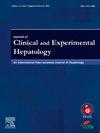First Series of Living Donor Liver Retransplants From India: Challenges and Outcomes
IF 3.3
Q2 GASTROENTEROLOGY & HEPATOLOGY
Journal of Clinical and Experimental Hepatology
Pub Date : 2024-11-10
DOI:10.1016/j.jceh.2024.102454
引用次数: 0
Abstract
Background
There is a paucity of Indian data on long-term survival after living donor liver transplant (LDLT) or the need for retransplant (re-LT). In this article, we report the first series of retransplants from India with focus on indications, technical challenges and results.
Methods
A retrospective study on 29 patients undergoing a liver retransplant (re-LT) was analysed with respect to survival outcomes and postoperative complications. Patients were divided into early and late retransplant groups based on whether re-LT was performed within or beyond 30 days of primary transplant.
Results
Liver retransplant was performed in 29 (0.81%) patients out of a total of 3563 liver transplants (28 living donor and one deceased donor liver transplant). The primary transplant was an LDLT in 27 (93%) patients. Retransplant was performed at a median of 26 days after the first transplant. Re-LT was performed early (within 30 days) in 17 (59%) patients and late (beyond 30 days) in 12 (41%). Hepatic artery thrombosis (53%) and early graft dysfunction (47%) were the indications for early retransplant, while biliary complications (50%) and chronic rejection (33%) were primary indications for late retransplant. Postretransplant complications occurred in 22 (75%) patients, the commonest being gram-negative bacterial sepsis. The 30-day mortality after retransplant was 27% (8/29). The primary cause of mortality was gram-negative septicaemia. The mortality in the late retransplant group (2, 16.6%) was lower than in the early retransplant group (6, 35%).
Conclusion
Retransplant using living donors is a viable option in properly selected patients with prior LDLT.
印度活体肝脏再移植的第一个系列:挑战和结果。
背景:印度缺乏活体供肝移植(LDLT)后长期生存或再次移植(re-LT)需要的数据。在这篇文章中,我们报道了印度的第一批再移植手术,重点是适应证、技术挑战和结果。方法:回顾性分析29例肝再移植(re-LT)患者的生存结局和术后并发症。根据首次移植后30天内或30天以上是否进行再移植,将患者分为早期和晚期再移植组。结果:3563例肝移植(28例活体供肝,1例死亡供肝)中,29例(0.81%)再次行肝移植。27例(93%)患者原发移植为LDLT。第一次移植后中位时间为26天再次移植。17例(59%)患者在早期(30天内)进行了Re-LT, 12例(41%)患者在晚期(超过30天)进行了Re-LT。肝动脉血栓形成(53%)和早期移植物功能障碍(47%)是早期再移植的指征,而胆道并发症(50%)和慢性排斥反应(33%)是晚期再移植的主要指征。22例(75%)患者出现移植后并发症,最常见的是革兰氏阴性细菌性败血症。再移植后30天死亡率为27%(8/29)。死亡的主要原因是革兰氏阴性败血症。晚期再移植组的死亡率(2.16.6%)低于早期再移植组(6.35%)。结论:适当选择既往LDLT患者,活体供体再移植是一种可行的选择。
本文章由计算机程序翻译,如有差异,请以英文原文为准。
求助全文
约1分钟内获得全文
求助全文
来源期刊

Journal of Clinical and Experimental Hepatology
GASTROENTEROLOGY & HEPATOLOGY-
CiteScore
4.90
自引率
16.70%
发文量
537
审稿时长
64 days
 求助内容:
求助内容: 应助结果提醒方式:
应助结果提醒方式:


